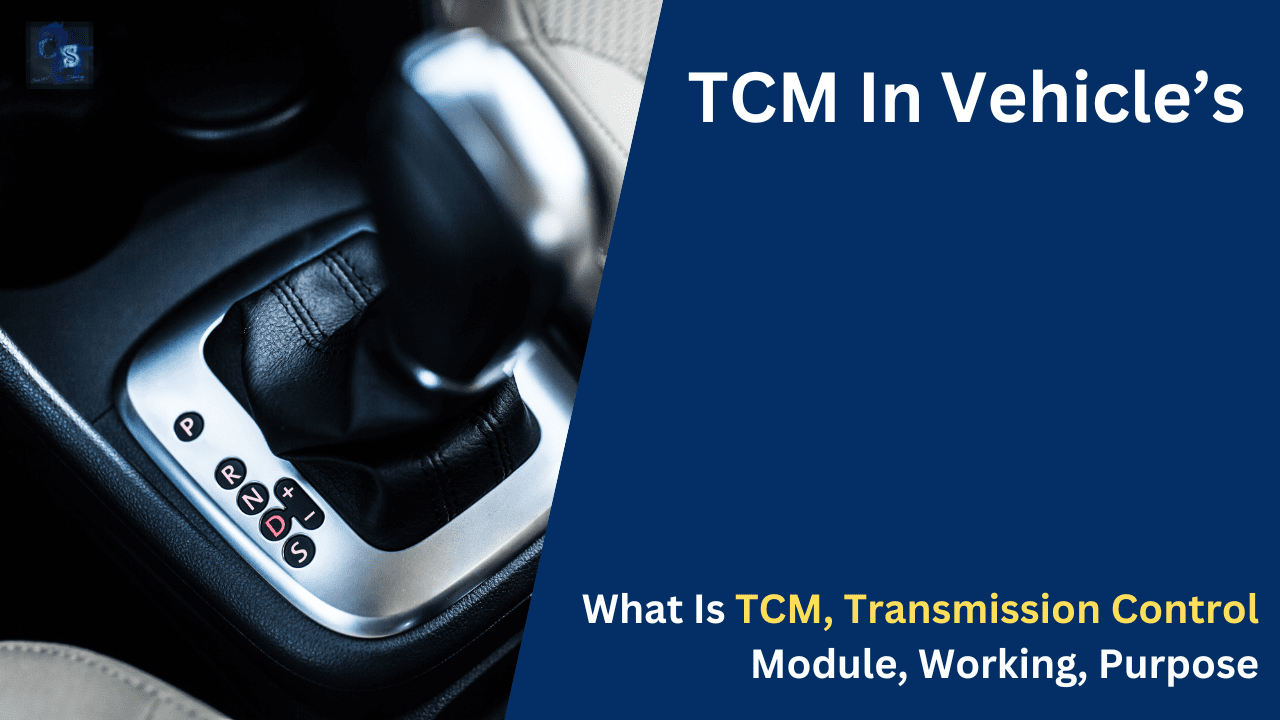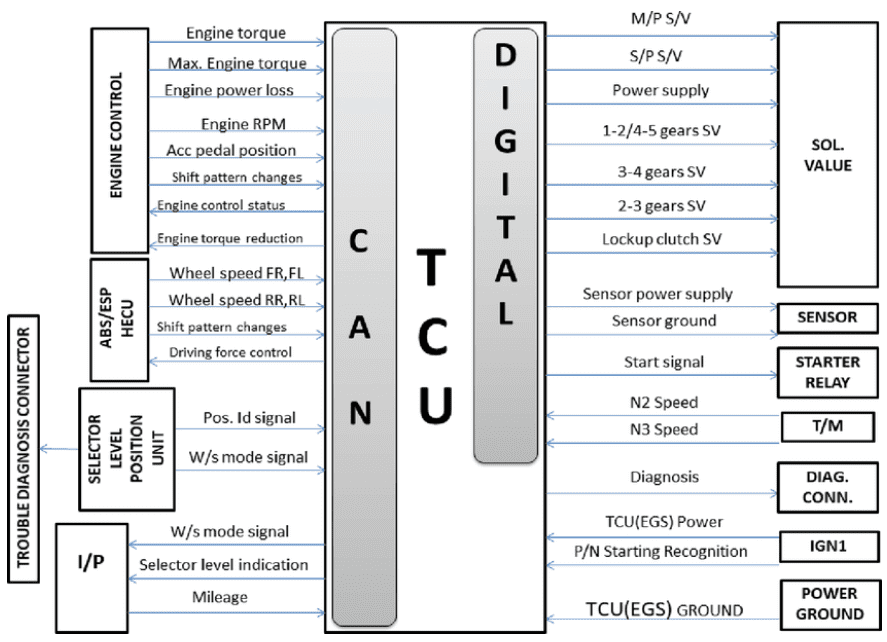What Is TCM, Transmission Control Module, Working, Purpose,
Hello guys, welcome back to our blog. Here in this article, we will discuss what is TCM, the transmission control module, the working of TCM, and what’s the purpose of TCM in vehicles.
Ask questions if you have any electrical, electronics, or computer science doubts. You can also catch me on Instagram – CS Electrical & Electronics.
Also, read:
- Top 100 HiL hardware in loop Interview Questions With Answers For Engineers
- Driver Monitoring Systems In Vehicles, Working, Driver Sleepy Alert
- Top 100 Automotive Interview Questions With Answers For Engineers
TCM, Transmission Control Module
TCM stands for Transmission Control Module. It is an essential component in modern vehicles with automatic transmissions. The TCM is responsible for controlling and managing the operation of the transmission based on inputs from various sensors. Its primary function is to optimize gear shifting, ensure smooth operation, and maximize fuel efficiency.
Monitoring Sensors: The TCM continuously receives input from various sensors located throughout the vehicle, including speed sensors, throttle position sensors, engine load sensors, and more. These inputs help the TCM determine the appropriate gear and shift points.
Gear Shifting: Based on the data received from sensors, the TCM determines when and how to shift gears. It controls solenoids or other mechanisms within the transmission to engage the appropriate gears for optimal performance and efficiency.
Adaptation and Learning: Modern TCMS are often adaptive and capable of learning from driving patterns. They can adjust shift points and timing based on the driver’s behavior and road conditions over time.
Diagnostic Functions: The TCM is also equipped with diagnostic capabilities to monitor the health and performance of the transmission system. It can detect faults or abnormalities and often communicates these issues to the vehicle’s onboard computer system for display as a warning light on the dashboard.
Communication: The TCM communicates with other systems within the vehicle, such as the engine control module (ECM), to ensure synchronized operation between the engine and transmission. This coordination is crucial for overall vehicle performance and efficiency.
If there is a malfunction or issue with the TCM, it can result in noticeable problems with the transmission, such as erratic shifting, slipping gears, or failure to engage gears properly. When diagnosing transmission issues, mechanics will often check the TCM for error codes and performance data to pinpoint the problem accurately.
Working Of TCM (Transmission Control Module)
When discussing the concept of “working” in the context of vehicle operation or transmission systems, it’s important to understand how these components function together to ensure smooth performance.
Firstly, the transmission in a vehicle is responsible for transferring power from the engine to the wheels at various speeds and torque levels. In an automatic transmission system, this process is managed by a complex arrangement of gears, clutches, and a torque converter. The torque converter allows the engine to keep running even when the vehicle is at a stop, providing smooth acceleration from rest.
The Transmission Control Module (TCM) plays a crucial role in this process. It acts as the brain of the transmission system, receiving real-time input from sensors positioned throughout the vehicle. These sensors monitor factors such as vehicle speed, engine load, throttle position, and transmission fluid temperature. The TCM uses this data to make informed decisions about gear selection, shift timing, and torque converter lock-up.
For instance, when you press the accelerator pedal to increase speed, the TCM analyzes the throttle position sensor’s input along with vehicle speed data. Based on this information, it determines the optimal gear for the current driving conditions and sends commands to engage the appropriate gear ratio.
The TCM is also responsible for adapting to driving patterns and conditions over time. Modern TCMs can learn from the driver’s behavior, adjusting shift points and transmission responses to optimize performance and fuel efficiency. This adaptive capability contributes to a smoother driving experience and improved overall vehicle operation.
In terms of vehicle performance, the proper functioning of the transmission and TCM is essential. A malfunctioning TCM can lead to issues such as erratic shifting, harsh gear engagements, or failure to shift into certain gears. These problems not only affect drivability but can also impact fuel economy and overall reliability.
Regular maintenance and diagnostics are key to ensuring that the transmission and TCM are working correctly. Mechanics can use diagnostic tools to read error codes stored in the TCM’s memory, pinpointing any potential issues that need to be addressed. Addressing transmission-related problems promptly can help prevent more significant and costly repairs down the line.
In conclusion, the “working” of a vehicle’s transmission system involves a sophisticated interplay between mechanical components and electronic controls, with the TCM serving as a vital interface. Understanding how these systems operate and maintaining them properly is crucial for ensuring optimal vehicle performance and longevity.
Purpose Of TCM (Transmission Control Module)
The Transmission Control Module (TCM) is a vital electronic component found in vehicles equipped with automatic transmissions. It serves as the brain of the transmission system, responsible for controlling and coordinating various functions to ensure optimal performance and efficiency. The TCM receives input from multiple sensors strategically positioned throughout the vehicle. These sensors gather data such as vehicle speed, engine RPM, throttle position, and transmission fluid temperature. By analyzing this information, the TCM can make informed decisions regarding gear selection, shift timing, and torque converter lock-up.
One of the primary functions of the TCM is to manage the operation of the transmission itself. This includes determining when to shift gears based on driving conditions and driver inputs. The TCM uses pre-programmed algorithms and logic to optimize gear shifts for factors like acceleration, deceleration, uphill or downhill driving, and towing loads. In automatic transmissions, the TCM controls the engagement and disengagement of gears and clutches, ensuring smooth transitions between gears and efficient power delivery to the wheels.
An essential feature of modern TCMs is their adaptive learning capability. These modules can analyze driving patterns over time and adjust transmission performance accordingly. By continuously monitoring driver behavior and road conditions, the TCM adapts shift points and transmission response to optimize fuel efficiency and driving comfort. Adaptive TCMs can also compensate for wear and tear on transmission components, prolonging the lifespan of the transmission system.
In addition to controlling transmission functions, the TCM is equipped with diagnostic capabilities. It can detect and store error codes related to transmission faults or abnormalities, such as solenoid malfunctions or sensor failures. Mechanics use specialized diagnostic tools to retrieve these error codes from the TCM’s memory and perform detailed inspections of the transmission system. This allows for accurate diagnosis and timely resolution of transmission-related issues, ensuring optimal vehicle performance and drivability.
Furthermore, the TCM communicates with other onboard control modules, such as the Engine Control Module (ECM), to coordinate the operation of the engine and transmission. This communication ensures seamless integration between the powertrain components, optimizing overall vehicle performance, efficiency, and drivability. In summary, the Transmission Control Module (TCM) is a sophisticated electronic device that plays a critical role in regulating and optimizing the operation of automatic transmissions. By continuously monitoring vehicle dynamics and driver inputs, the TCM ensures smooth gear shifts, efficient power delivery, and enhanced driving performance and safety.
I hope this article may help you all a lot. Thank you for reading “TCM, Transmission Control Module“.
Also, read:
- 1000+ Automotive Interview Questions With Answers
- RTOS In The Automotive Industry: The Brains Behind Real-Time Vehicle Control
- High Performance Computers in Software-Defined Vehicles (SDVs): Architecture, Challenges, and Future Trends
- Automotive HPC Wars: The Race To Power Software-Defined Vehicles
- Why The Automotive Industry Is Down: No Automotive Jobs and When Will It Become Normal Again?
- Lane Departure Warning Systems: Your Guardian on the Road
- In-Depth Guide To UDS Service 0x19 – ReadDTCInformation
- Testing Techniques For Test Case Writing in the Automotive Domain


